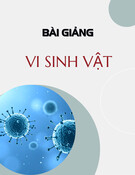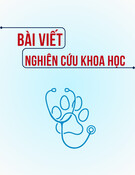
No 14 - 12.2024 - Hoa Binh University Journal of Science and Technology 123
PHARMACEUTICALS
ORGANIC SELENIZED COMPOUNDS IN GARLIC AS POTENTIAL
CHEMEATHERAPY AGENT TO IMPROVE CANCER TREATMENT
Assoc. Prof., Dr. Phan Tuy
Hoa Binh University
Corresponding Author: phantuy@daihochoabinh.edu.vn
Received: 02/12/2024
Accepted: 09/12/2024
Published: 24/12/2024
Abstract
Garlic has been utilized since ancient times for both culinary and medicinal purposes. Recent
research has identified selenium compounds in garlic, including γ-Glutamyl-Se-methylselenocysteine
(GGMSC), leading to the hypothesis that GGMSC acts as a carrier for Se-methylselenocysteine
(MSC). Experiments conducted on animals by researchers indicate that the effects of GGMSC in
garlic and MSC on cancer cells in experimental models are equivalent. This finding suggests that
garlic is a potential chemotherapeutic agent to enhance cancer treatment.
Key words: Garlic, Organic Selenium, Se-methylselenocysteine (MSC).
Hợp chất Selen hữu cơ trong tỏi như tác nhân hóa trị liệu tiềm năng để cải thiện điều trị ung
thư
PGS.TS Phan Túy
Trường Đại học Hòa Bình
Tác giả liên hệ: phantuy@daihochoabinh.edu.vn
Tóm tắt
Tỏi đã được sử dụng từ thời cổ đại cho cả mục đích ẩm thực và y học. Nghiên cứu gần đây đã
phát hiện các hợp chất selenium trong tỏi, bao gồm γ-Glutamyl-Se-methylselenocysteine (GGMSC),
dẫn đến giả thuyết rằng GGMSC đóng vai trò như một chất mang cho Se-methylselenocysteine
(MSC). Các thí nghiệm được thực hiện trên động vật bởi các nhà nghiên cứu chỉ ra rằng tác dụng
của GGMSC trong tỏi và MSC đối với các tế bào ung thư trong các mô hình thí nghiệm là tương
đương nhau. Phát hiện này gợi ý rằng tỏi có thể là một tác nhân hóa trị tiềm năng để hỗ trợ điều
trị ung thư.
Từ khóa: Tỏi, Selenium hữu cơ, Se-methylselenocysteine (MSC).
Introduction
Garlic, scientifically known as Allium
sativum L., belongs to the onion family
(Alliaceae). It has been used by humans for
thousands of years. In ancient Egypt, garlic was
valued not only for its culinary applications but
also for its health and therapeutic benefits.
The main chemical components isolated
from garlic extracts include sulfur-containing
compounds such as alliin, allicin, ajoenes,
vinyldithiins and sulfides
Garlic products are used by humans as a
source of medicine in many ways in today's
life. Researchers from various disciplines are
currently working to explore the medicinal
value of garlic for human health.
Researchers are primarily concerned with
the medicinal value of garlic for its broad-
spectrum therapeutic effects with minimal
toxicity. Garlic extract exhibits antibacterial

124 Hoa Binh University Journal of Science and Technology - No 14 - 12.2024
PHARMACEUTICALS
activity against various types of bacteria, fungi
and viruses. From the chemical composition
of garlic, Numerous studies have highlighted
the efficacy of garlic preparations in treating
cardiovascular diseases, cancer, diabetes,
hypertension, and atherosclerosis. Selenium,
an essential trace element and antioxidant, is
known for its cancer prevention properties.
Extensive research has focused on the role
of organic selenium in cancer treatment [1-
2]. Evidence suggests that selenium intake is
effective in cancer prevention. To biological
enrich selenium-deficient areas, soil can be
fertilized with selenium-rich compounds
to increase the selenium content in garlic
[3]. According to a study conducted at the
Jiangsu Provincial Center for Disease Control
and Prevention in China, individuals who
consumed raw garlic at least twice a week over
a seven-year period exhibited a 44% lower risk
of lung cancer.
In Vietnam, garlic is grown throughout the
country and is used as a culinary and medicinal
ingredient. Recently, scientists have discovered
the cancer-treating effects of garlic. Therefore,
it is necessary to study and research to improve
the anti-cancer effects of garlic.
1. Selenium and organic selenium in garlic
We all know that the content of trace
elements in plants, tubers, and fruits depends
a lot on the content of those elements in the
growing environment. In particular, plants
containing a lot of sulfur such as garlic, if
fertilized with a lot of fertilizer containing
selenium, the selenium content in garlic
increases [3]. This happens because the
properties of sulfur and selenium are very
similar, so selenium easily replaces sulfur in
sulfur-containing compounds.
The major selenium-containing compound
in natural garlic and selenium-fertilized
garlic has been identified as γ-Glutamyl-Se-
methylselenocysteine (GGMSC) and it is
hypothesized that GGMSC mainly acts as a
carrier of Se-methylselenocysteine (MSC)- an
organic selenium with anticancer effects [4].
The structures of these two compounds are
illustrated in the following figure:
The authors of this study conducted
experiments to demonstrate that GGMSC is a
carrier of MSC. Selenomethionine (MSC) is a
natural amino acid found in some plant materials
such as cereals, soybeans, and enriched yeast,
but it cannot be synthesized in animals or
humans.
GGMSC is found naturally in garlic,
accounting for ~31% of the total Se in garlic and
~53% in commercial garlic powder [5].
2. Se-methylselenocysteine (MSC) reduces
the toxicity and enhances the antitumor
activity of anticancer drugs in chemotherapy
Cancer is gradually becoming a “burden”
for many countries in the world, including
Vietnam. The rate of cancer in our country is
increasing. There are about 100 types of cancer
and this dangerous disease can occur at many
different ages. However, middle-aged people
often have a higher rate of disease.
Cancer is a dangerous disease, but if
detected early and treated properly, cancer can
be cured. Common cancer treatments today are
surgery, radiotherapy, chemotherapy and some
other treatments such as endocrine therapy,
targeted therapy, etc.
Chemotherapy is a treatment method
commonly used to treat patients with advanced
cancer, when surgery or radiotherapy cannot be
highly effective. Some drugs and chemicals for
cancer treatment can prevent the development
of cancer, but they are all toxic to cells. Toxicity
GGMSC can be considered as a carrier of Se-methylselenocysteine (MSC).

No 14 - 12.2024 - Hoa Binh University Journal of Science and Technology 125
PHARMACEUTICALS
caused by chemotherapy is often a factor that
hinders cancer treatment, limiting treatment
time and increasing doses. Therefore, there is a
need for new approaches to develop new agents
or combination regimens to reduce toxicity and
increase selectivity of cancer treatment drugs,
counteract the toxicity caused by chemotherapy,
bringing the potential for using higher doses of
chemotherapy in the hope of overcoming drug
resistance.
It has been shown that antioxidant
compounds such as curcumin and some selenium
compounds have protective effects against
cisplatin (CDDP)-induced nephrotoxicity. In a
study [6], the authors evaluated the effects of
MSCs on the toxicity and antitumor activity of
four drugs Cyclophosphamide (CTX), CDDP,
oxaliplatin, and irinotecan in Fischer rats.
Cisplatin(cis-diamminedichloroplatinum)is
a platinum complex used in the treatment of a
variety of malignancies. The antitumor activity
of CDDP is related to DNA synthesis through
the formation of interstrand and intrastrand DNA
cross-links. The known toxicities of CDDP are
nephrotoxicity, myelotoxicity, neurotoxicity,
ototoxicity,aandagastrointestinalatoxicity.
Nephrotoxicity is the major dose-limiting
toxicity. The major route of excretion of CDDP
is via the kidneys, and it accumulates in the renal
cortex, leading to renal failure, hypokalemia,
and hypomagnesemia.
Cyclophosphamide (CTX) is often combined
with other drugs to treat many malignant
diseases such as: Ovarian cancer, Breast cancer,
Small cell lung cancer... Reversible leukopenia,
thrombocytopenia, anemia, anorexia, nausea,
vomiting, diarrhea, stomatitis, mucositis,
skin rash, flushing, urticaria, hair loss, aseptic
cystitis, microscopic/gross hematuria, headache,
conjunctivitis, jaundice...
Oxaliplatin - a platinum complex, is a drug
used to treat advanced colorectal cancer. It is
the only platinum compound active against
colorectal cancer. Oxaliplatin is mainly used
in combination with other chemotherapeutic
agents, including irinotecan. Toxicities of
oxaliplatin include neuropathy, diarrhea,
myelotoxicity, and mucositis.
Irinotecan (CPT-11) is used in combination
for the treatment of patients with advanced
colorectal cancer. Late-onset diarrhea is the
dose-limiting toxicity of irinotecan. Although
high-dose loperamide is used to prevent
diarrhea caused by CPT-11, efficacy is limited.
Neutropenia is another serious adverse event of
irinotecan treatment, with transient neutropenia
occurring in 80% of patients, severe neutropenia,
and febrile neutropenia occurring in 47% and
15%, respectively.
The results of the mouse study of this study
[6] showed that: The researchers combined MSCs
with CTX, CDDP, oxaliplatin or irinotecan, orally
daily for 14 days or 7 days before chemotherapy
and for 7 days after drug administration. For the
combination of MSCs and irinotecan, MSCs
were administered orally for a total of 35 days.
The obtained data demonstrated that except
for CTX, MSCs had a complete protective effect
against toxicity induced by doses of CDDP,
oxaliplatin and irinotecan, Optimal protection
from chemotherapy-induced toxicity was
achieved only when MSCs were treated prior to
drug treatment.
Alopecia is another major side effect of
patients treated with CTX. Alopecia is caused by
the shedding of the rapidly dividing epithelium
of the hair follicle. Currently, there is a lack of
good animal models for studying chemotherapy-
induced alopecia. Because it is difficult to
demonstrate a direct protective effect of MSCs
on CTX-induced alopecia, the researchers
chose the post-shave hair regrowth method to
evaluate the effects of MSCs. The data clearly
demonstrated that when CTX was combined

126 Hoa Binh University Journal of Science and Technology - No 14 - 12.2024
PHARMACEUTICALS
with MSCs, normal hair growth occurred in mice
that had been shaved prior to treatment.
In conclusion, the obtained research
results clearly demonstrated that MSCs are
highly selective and effective modulators of
the therapeutic efficacy and toxicity of various
chemotherapeutic agents in animal models.
3. Se-methylselenocysteine (MSC) is a Cancer
Therapeutic Agent
Selenomethionine (MSC) is highly
bioavailable in humans and exhibits favorable
pharmacokinetic properties with a short half-life
and low risk of chronic selenosis. The tumoricidal
activity of MSC has been demonstrated in several
cancer cell lines.
All cancer cells exhibit an uncontrolled
growth pattern and have the ability to metastasize,
resulting in a lethal malignancy. To support this
relentless cell division and proliferation, cancer
cells undergo abnormal metabolic adaptations
to promote their survival. Although the
mechanisms of cellular transformation during
carcinogenesis in different cell types may occur
in different ways, the metabolic requirements of
cancer cells are generally very similar. Equally
remarkable for the energy adaptations that
cancer cells have is their exceptional ability
to withstand the increased environmental
oxidation caused by their abnormal metabolism.
Malignant cancer cells depend on high levels of
intracellular reactive oxygen species (ROS) for
proliferation, self-renewal, and metastasis. That
is, these types of cancer cells maintain high
levels of ROS compared to normal cells, creating
oxidative stress. From here, scientists have
proposed a new cancer treatment strategy called
Modulation of oxidative stress as an anticancer
strategy [7]. In this method, Selenomethionine
(MSC) can be used. Selenomethionine (MSC)
acts as a pro-oxidase [8]. MCS are metabolized
by several distinct pathways that produce
different Se metabolites, which in turn determine
their specific biological activity. Among the
metabolites generated, hydrogenselenide
(HSe-) and methyl selenol (CH3Se-) act as
antioxidants and play a central role in the redox
cycle with glutathione (GSH) or the Trx/Grx
system (Trx-Thioredoxin); Grx glutaredoxin),,
generating superoxide and hydrogen peroxide,
which generate new ROS generation. Hydrogen
peroxide is the key molecule that determines the
fate of cancer cell survival. Because cancer cells
already have high levels of ROS. MSCs continue
to generate additional ROS. This causes cancer
cells to die [7]. In contrast, healthy cells have
steady-state levels of ROS. Therefore, in the
case of increased ROS levels in normal non-
cancerous cells, they can be neutralized by the
body's antioxidant system.
Thus, Selenomethionine (MSC) has the effect
of both reducing side effects in chemotherapy
and destroying cancer cells.
To confirm that γ-Glutamyl-Se-
methylselenocysteine (GGMSC) is a carrier of
Se-methylselenocysteine (MSC) and has the
same anti-cancer effect as MSC, scientists [4]
conducted experiments comparing the anti-cancer
effects of GGMSC with MSC in mice. The study
was designed to compare the in vivo responses
of GGMSC and MSC using various biochemical
and biological endpoints, including: (a) tissue
accumulation profiles; (b) urinary Se excretion
following bolus doses; (c) anti-cancer efficacy;
and (d) gene expression changes determined
by cDNA array analysis. The results indicated
that GGMSC primarily functions as a carrier
for MSC. In carcinogenic mice, treatment with
either GGMSC or MSC led to a lower incidence
of premalignant lesions in the mammary gland
and a lower occurrence of breast cancer as these
early lesions progressed to malignancy.
4. Discussion
Documents show that garlic contains the
compound γ-Glutamyl-Se-methylselenocysteine
(GGMSC) and GGMSC is a carrier of Se-
methylselenocysteine (MSC)- and GGMSC has
anti-cancer effects like MSC, thus garlic is a
potential chemotherapy.
Since ancient times, garlic has been used
as a spice and medicine, but little attention has
been paid to the therapeutic effects of selenium
and selenium compounds in garlic. Selenium
has two sides. At reasonable levels, selenium is
a medicine, but at high levels, selenium is toxic.

No 14 - 12.2024 - Hoa Binh University Journal of Science and Technology 127
PHARMACEUTICALS
On the other hand, the selenium content in garlic
depends on the selenium content in the soil where
garlic is grown.
In Vietnam, garlic is used as a spice and
medicine and is grown throughout the country.
Therefore, to make garlic a chemotherapy agent
in cancer treatment, it is necessary to standardize
the selenium content in garlic and choose a
locality and garlic growing technique that meets
that requirement.
References
[1] Valentina Gandina, Prajakta Khalkarb, Jeremy Braudea, Aristi P. Fernandes, “Organic selenium
compounds as potential chemotherapeutic agents for improved cancer treatment”, Free Radical Biology and
Medicine, 127 (2018) 80–97, 2018.
[2] Margaret P. Raymana, Kristian Hillert Wintherb, Roberto Pastor-Barriusoc, Frederick Coldd,Marianne
Thvilumb, Saverio Strangese,f, Eliseo Guallarg, Søren Cold, “Effect of long-term selenium supplementation
on mortality: Results from a multiple-dose, randomised controlled trial”, Free Radical Biology and Medicine,
127 (2018) 46–54, 2018.
[3] Murat Alo Turan, et al., ‘Selenium Concentration of Garlic Bulbs Grown in Different Parts of Turkey”,
Asian Journal of Chemistry, Vol. 22, No. 8 (2010), 6563-6568, 2010.
[4] Yan Dong, Donald Lisk, et al., “Characterization of the Biological Activity of γ-Glutamyl-Se-
methylselenocysteine A Novel, Naturally Occurring Anticancer Agent from Garlic”, Cancer Research, 61
(7):2923-8, 2001.
[5] Kotrebai M., Birringer M., et al., “Selenium speciation in enriched and natural samples by HPLC-ICP-
MS and HPLC-ESI-MS with perfluorinated carboxylic acid ion-pairing agents”, Analyst, 125(1)71-8. DOI:
10.1039/a906320j.
[6] S Cao, F A Durrani, K Tóth, and Y M Rustum, “Se-methylselenocysteine offers selective protection
against toxicity and potentiates the antitumour activity of anticancer drugs in preclinical animal models”, Br J
Cancer, 2014 Apr 1; 110(7): 1733–1743). DOI: 10.1038/bjc.2014.85.
[7] C. Gorrini, I.S. Harris, T.W. Mak, “Modulation of oxidative stress as an anticancer strategy”, Nat. Rev.
Drug Discov, 2013. DOI: 10.1038/nrd4002.

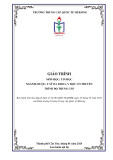



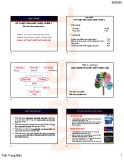





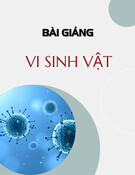
![Bài giảng Vi sinh vật: Đại cương về miễn dịch và ứng dụng [chuẩn nhất]](https://cdn.tailieu.vn/images/document/thumbnail/2025/20251124/royalnguyen223@gmail.com/135x160/49791764038504.jpg)
